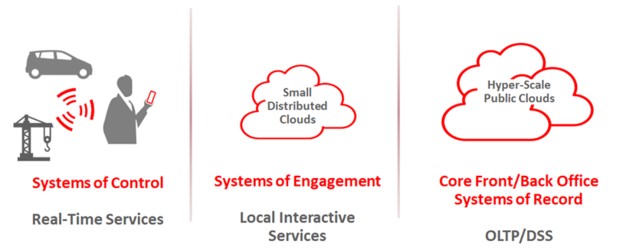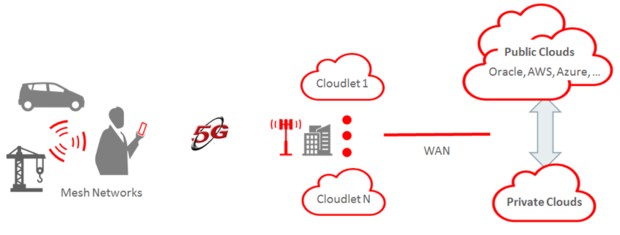Today, we can’t rely on the magic of cloud computing to deliver better resources. In short, it is unfortunately inescapable that “long WAN latencies are a fundamental obstacle. Even trivial user-application interactions incur these delays in cloud computing.” Beyond those trivial apps, we already have mobile apps trying to deliver advanced, computation-intense capabilities like speech recognition, NLP, assisted vision, machine learning, and augmented reality. Those apps suffer because cloud computing isn’t powerful enough to support them seamlessly across a WAN like the public internet.
MAUI researchers believe that “Rather than relying on a distant cloud, the resource poverty of a mobile device can be addressed by using a nearby resource-rich cloudlet.”
A bit of a stretch? Let me explain.
The number of users using mobile phones to connect with the internet is rising continuously. In addition to the server hardware and static client, mobile hardware is recognized as a necessary resource. Compared to static servers and clients, there are many drawbacks associated with mobile devices. The computational resources of the mobile device are limited by memory, battery life, and weight and height dissipation.

ENTER CLOUDLETS…
Cloudlets are a way of moving cloud computing capacity closer to intelligent devices at the edge of the network. It is a small-scale data center or cluster of computers designed to quickly provide cloud computing services to mobile devices, such as smartphones, tablets, and wearable devices, within close geographical proximity. The goal of a cloudlet is to increase the response time of applications running on mobile devices by using low latency, high-bandwidth wireless connectivity, and by hosting cloud computing resources, such as virtual machines, physically closer to the mobile devices accessing them.
This is intended to eliminate the wide-area network (WAN) latency delays that can occur in traditional cloud computing models. It was specifically designed to support interactive and resource-intensive especially for mobile applications, such as those for speech recognition, language processing, machine learning, and virtual reality because cloud computing could not provide full support to mobile scenarios, especially for the high-speed vehicle-mounted network environments, in which drivers must quickly learn about the road conditions and traffic flow in real-time.

Cloudlets is a technological innovation implementing AI and IoT. Many enterprises and organizations in the industry have begun to deploy the ecosystem of cloudlets, including communications vendors like Cisco and Huawei, as well as many cloud computing and IoT enterprises like Zhiyun and Gizwits 4.0. On November 19, 2015, Cisco collaborated with ARM, Dell, Intel, Microsoft, and Princeton University to create the OpenFog(Cloudlets) Alliance, aiming to develop fog computing-related technical standards and promote technical transformation in the industry.
Bit of History…
A prototype implementation of a cloudlet was originally developed by Carnegie Mellon University as a research project, starting in 2009. The term cloudlet was coined by computer scientists Mahadev Satyanarayanan, Victor Bahl, Ramón Cáceres and Nigel Davies. These researchers define cloudlets as the middle tier of a three-tier hierarchy: intelligent device, cloudlet, and cloud.
Why we need Cloudlets…
Cloudlets are beneficial because they allow their users to instantiate custom virtual machines rapidly on the running cloudlet, which requires software in a thin client fashion. A novel architecture for a carrier-managed WLAN network that leverages the virtualization of network functions and concepts. It was concluded that the WLAN cloudlet solution offered different advantages in terms of agility, flexibility, and costs. The benefits of cloudlet-based WLAN include the following
- reduced
equipment cost - decreased
access latency - flexibility
- network
management - faster
configuration of new services - new
revenues - possibility
of introducing new services.
What is different with Cloudlets than other Public Cloud Data Center you ask…
Before going into differentiation, we need to understand that Cloudlet is considered a form of cloud computing because it delivers hosted services to users over a network.
First, a cloudlet is self-managed by the businesses or users that employ it, while a public cloud data center is managed full-time by a cloud provider. Second, a cloudlet predominantly uses a local area network (LAN) for connectivity, versus the public Internet. Thirdly, a cloudlet is employed by fewer, more localized users than a major public cloud service. Finally, a cloudlet contains only “soft state” copies of data, such as a cached copy, or code that is stored elsewhere
Conclusion and Future Work…
The cloudlet provisioning mechanism for our current working prototype to enable lower energy consumption on the mobile device, place fewer requirements on mobile devices, and simplify provisioning in planned environments.
Future work on this is related to security, establishing the initial trust between mobile devices and cloudlets, which can be:
- As a mobile device, is what I discovered really
a “friendly” cloudlet? - As a cloudlet, did that offloading request
really come from a “friendly” mobile device?
The goal is to explore solutions for establishing trusted identities in disconnected environments with the advantage/constraint that computed cloudlets are not meant to be long-lived, meaning that they are pre-provisioned and eventually deployed to support a mission.
This blog has been co-authored by Abhilasha Srivastava

Working as a consultant with Sogeti India, OneDeliver from last 1.9 years and actively contributed to projects in the area of cloud assessment, infrastructure and migration. Currently supporting cloud run services for multiple customers and passionate technology advocate who looks to discover ways to transform/automate businesses functions. Area of interest is DevOps which includes IaC and infrastructure management.

 English | EN
English | EN 